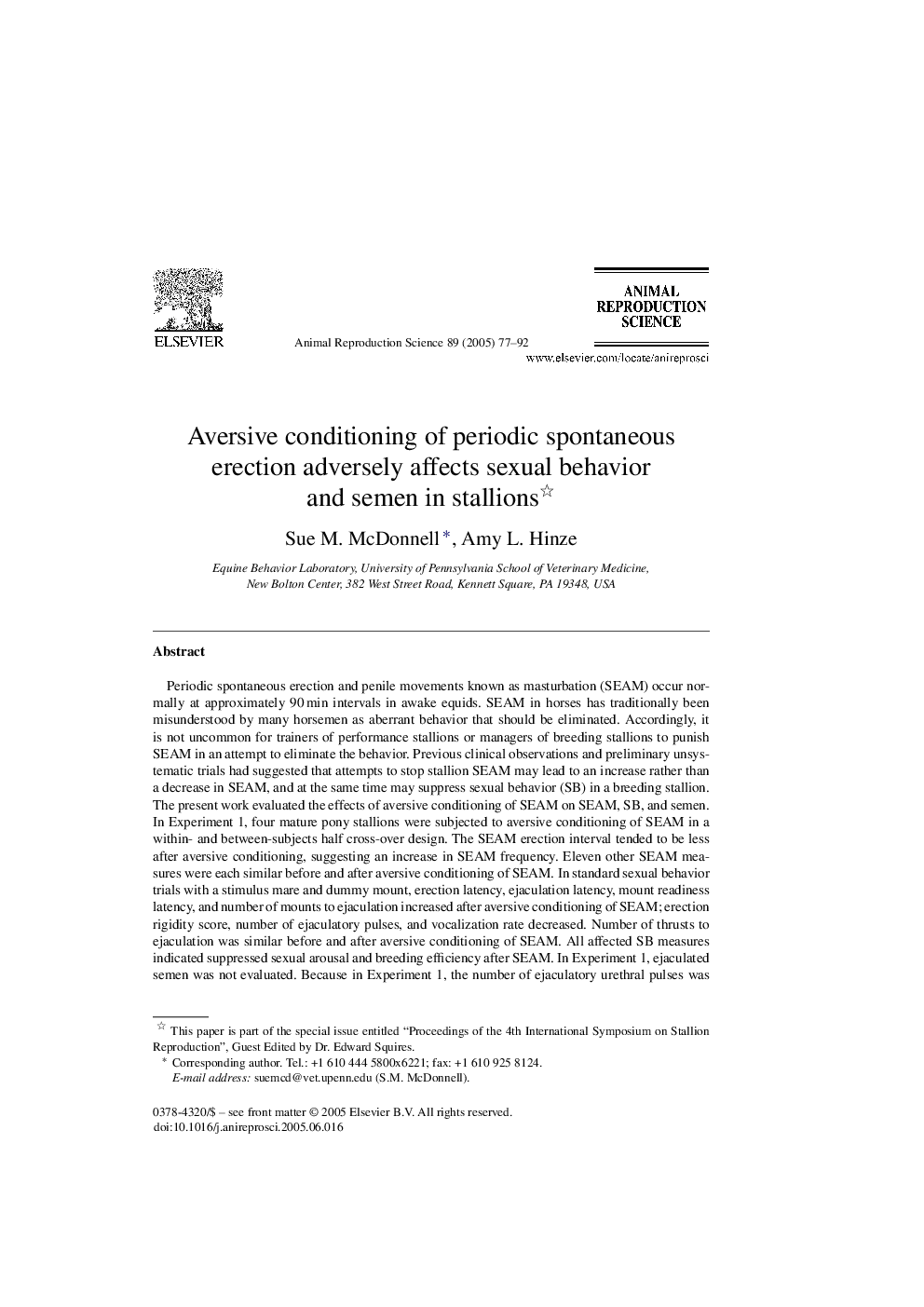| کد مقاله | کد نشریه | سال انتشار | مقاله انگلیسی | نسخه تمام متن |
|---|---|---|---|---|
| 9900253 | 1544836 | 2005 | 16 صفحه PDF | دانلود رایگان |
عنوان انگلیسی مقاله ISI
Aversive conditioning of periodic spontaneous erection adversely affects sexual behavior and semen in stallions
دانلود مقاله + سفارش ترجمه
دانلود مقاله ISI انگلیسی
رایگان برای ایرانیان
کلمات کلیدی
موضوعات مرتبط
علوم زیستی و بیوفناوری
علوم کشاورزی و بیولوژیک
علوم دامی و جانورشناسی
پیش نمایش صفحه اول مقاله

چکیده انگلیسی
Periodic spontaneous erection and penile movements known as masturbation (SEAM) occur normally at approximately 90Â min intervals in awake equids. SEAM in horses has traditionally been misunderstood by many horsemen as aberrant behavior that should be eliminated. Accordingly, it is not uncommon for trainers of performance stallions or managers of breeding stallions to punish SEAM in an attempt to eliminate the behavior. Previous clinical observations and preliminary unsystematic trials had suggested that attempts to stop stallion SEAM may lead to an increase rather than a decrease in SEAM, and at the same time may suppress sexual behavior (SB) in a breeding stallion. The present work evaluated the effects of aversive conditioning of SEAM on SEAM, SB, and semen. In Experiment 1, four mature pony stallions were subjected to aversive conditioning of SEAM in a within- and between-subjects half cross-over design. The SEAM erection interval tended to be less after aversive conditioning, suggesting an increase in SEAM frequency. Eleven other SEAM measures were each similar before and after aversive conditioning of SEAM. In standard sexual behavior trials with a stimulus mare and dummy mount, erection latency, ejaculation latency, mount readiness latency, and number of mounts to ejaculation increased after aversive conditioning of SEAM; erection rigidity score, number of ejaculatory pulses, and vocalization rate decreased. Number of thrusts to ejaculation was similar before and after aversive conditioning of SEAM. All affected SB measures indicated suppressed sexual arousal and breeding efficiency after SEAM. In Experiment 1, ejaculated semen was not evaluated. Because in Experiment 1, the number of ejaculatory urethral pulses was less after aversive conditioning, Experiment 2 was similarly designed, but included evaluation of semen, both immediately and again 1 week after aversive conditioning was completed. Experiment 2 included 12 aversively conditioned stallions, and 4 yoked controls. In Experiment 2, masturbation episode duration tended to be less after aversive conditioning, while the remaining 11 SEAM measures were unaffected by aversive conditioning of SEAM. Of SB measures, erection latency, mount readiness latency, thrusts to ejaculation, and ejaculation latency were significantly greater after aversive conditioning. Erection rigidity score and number of ejaculatory pulses were less after aversive conditioning. These differences are consistent with suppressed sexual arousal and reduced breeding efficiency. Semen volume and total number of sperm per ejaculate were significantly less after aversive conditioning. These findings are consistent with clinical anecdotes and preliminary trials indicating that aversive conditioning of SEAM in stallions suppresses sexual arousal and breeding behavior. Of considerable interest both clinically and theoretically, is the finding that aversive conditioning target behavior of SEAM was not suppressed by aversive conditioning, while SB and semen during semen collection trials were both adversely affected.
ناشر
Database: Elsevier - ScienceDirect (ساینس دایرکت)
Journal: Animal Reproduction Science - Volume 89, Issues 1â4, October 2005, Pages 77-92
Journal: Animal Reproduction Science - Volume 89, Issues 1â4, October 2005, Pages 77-92
نویسندگان
Sue M. McDonnell, Amy L. Hinze,